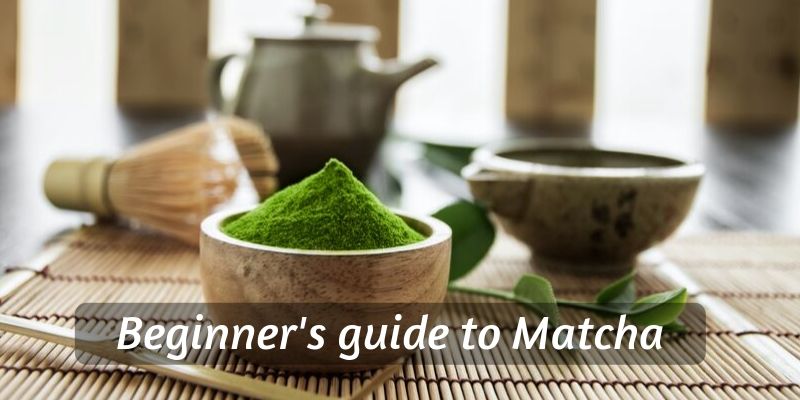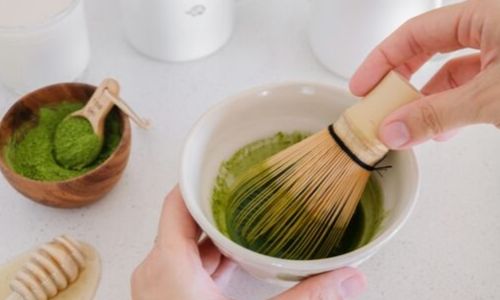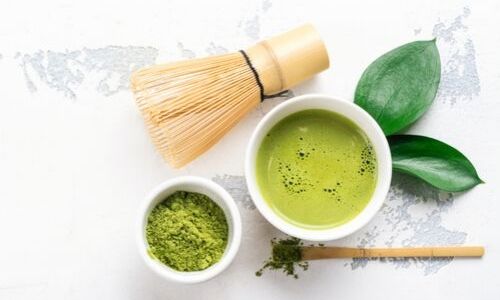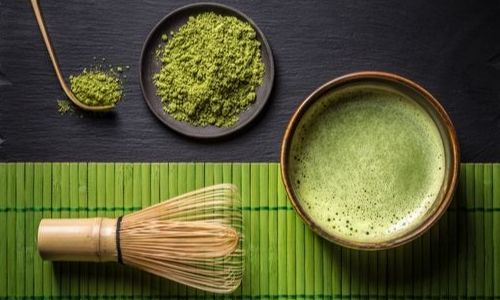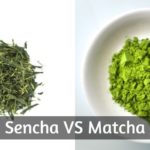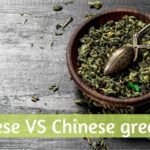Matcha is all over the place lately. In the past couple of decades it rose in popularity and has become recognized as a superfood. You'll find it nearly everywhere and available at most coffee shops, in baked goods, and especially health shops.
While this powdered tea is amazing, few actually know what's up with it, how it's made, or even how to drink it properly.
So let this beginner's guide explain everything, and hopefully you'll find it very useful in the long run.
Table of Contents
What is Matcha ?
Matcha is a form of green tea, but powdered and mixed with hot water to form a thick drink. It's made from the leaves of the Camellia sinensis plant, and the leaves are dried and ground into a very fine powder.
The process is very specific, and entails cutting out the stem and main veins of the tea leaves (more details further in the article).
Matcha has Chinese roots, but became popular in feudal Japan, and is now known as a Japanese item. It's part of the Japanese tea ceremony, which has deep roots in the culture and traditions of the nation.
Drinking Matcha is very different from drinking any other tea, partly because of the taste and partly because it's not a brew, but rather a suspension.
Even so, you'll find Matcha as an added ingredient to many food or drink items. It both gives color and a very specific flavor, though nearly all the health benefits are lost due to the added sugar, milk, and carbs.
Where does Matcha come from ?
Most of the time you'll find Matcha of Japanese origin. This is because that's where most of the consumption is, so that's also where it's grown mostly.
But the Chinese are taking interest in Matcha again, so you might find Chinese Matcha as well. Other Southeast Asian countries might produce Matcha as well, since they also produce regular green tea.
I mean countries such as Indonesia, Thailand, Taiwan, and so on.
As for where the idea for Matcha first came up, the answer is mainland China.
Back when they were drinking green tea and keeping it in the form of pressed bricks - which later led to Pu'erh - they also started drying it out, and grinding the leaves into a fine powder using a grindstone.
This powder was mixed with water, and salt was added to it, and drank as such. It was popular with the Buddhist monks, but not nearly as popular as it became in Japan.
Back in 1191 one Buddhist monk came to Japan, and brought Matcha with him. This monk was Eisai, and he was responsible for propagating the Rinzai school of Buddhism and the ceremonial value of Matcha.
The two (religion and Matcha) became very closely connected, and also very popular with the Japanese elite. After a while it became available to the common folk as well, but even then it was expensive, as it is now.
This is partly due to its status, and partly due to the amount of labor necessary to make a batch of Matcha powder.
What is Matcha made of ?
Matcha is made from the leaves of the Camellia sinensis plant, but they've been treated differently than regular green tea leaves. The process for making Matcha is a bit complicated, but still reasonably easy to follow if explained properly.
We begin with the tea plant. The bushes that are meant to produce Matcha leaves are prepared as early as 20 days before picking, to make sure the leaves grow as they should.
Matcha needs to be grown in the shade, to maximize flavor and shield it from harsh sun and heat that might damage the flavor. So the bushes are covered, most of the time, to protect them.
The comes harvesting time. The best leaves to pick are at the top of the tea plant. There you'll find the most tender and fresh leaves, and they get progressively older and tougher as you go down the plant.
The higher leaves are use for ceremonial and premium Matcha, while lower leaves are used for food-grade/cooking Matcha.
Once the leaves are picked, they're steamed to stop any oxidation from happening and changing the flavor. Steaming is a better way of preserving the true flavor of green tea, as opposed to firing the leaves in a pan or oven as most green teas are treated.
Once the leaves are steamed, they are dried out. And one dried, they can either become Gyokuro - a very pure form of green tea - or processed to become Matcha.
For Matcha, the leaves are deveined, and the stems of the leaves are removed. This is time consuming and requires patience and an eye for detail.
This step makes sure you get only the most tender part of the leaf, and that there are no inconsistencies when the powder is mixed into the water. Otherwise it could lead to very serious flavor discrepancies.
Once this is done, what's left of the dried leaves is ground into a very fine powder. The higher grade Matcha made from the top leaves will be fine, very powdery.
The lower grade or culinary grade will be a bit sandy or rougher in texture.
The final product should be an unreal shade of green, bright and vibrant. It's not dye, but the color from the crushed leaves. If your Matcha is fresh, it should be bright green. Maybe a little darker or lighter, but definitely vibrant.
If it's a little faded or starting to yellow, it's past its prime.
Culinary grade Matcha vs ceremony vs premium Matcha
The main differences between culinary, premium, and ceremony are kind of subtle, and there are no strict rules to achieve each of these.
- Ceremony grade is the highest grade. Has slight Umami flavor, nearly no bitterness, very smooth taste.
- Premium grade is still fresh but not as delicious as ceremony grade, might be a tiny bit bitter in some cases
- Culinary grade may often have a slight bitterness to it due to the leaves used, will be less bright in color
Ceremony grade is only used in tea ceremonies and very important events.
Premium is easy to get a hold of but expensive. Still available to the general public.
Culinary grade is what you'll most often find on the market, and what you'll always find in foodstuffs. Matcha lattes, icecream, muffins, pancakes, Matcha anything is done with culinary grade.
Why is Matcha expensive ?
The high pricepoint of Matcha is due to how much care the farmers have to take of the plants while they grow. To make sure they get the right amount of shade, but alto a bit of sun.
The fact that not all the leaves are used for Matcha. The entire processing method of the leaves after picking is very tedious and requires either very patient labor workers, or very well programmed machines with good software.
In short, it's not easy to make. So there's a low offer in comparison to the demand.
There's also the fact that Matcha is rising in popularity and this increases the demand, and also its status as a semi-luxury item.
It can get to prices such as $2/ounce for culinary grade Matcha, and the ceremonial grade can get to $10/ounce. Just looking at the price might make you want to turn tail, but think about how much work went into this tea powder.
It's really not something to play around with, so using it sparingly and for special occasions seems to fit most folks.
Does Matcha expire and can you still use it ?
Yes and no.
Yes, Matcha can expire in that it's lost most of its properties, has lost its bright green hue and might've turned a little yellow in time.
This happens, but does not turn the Matcha powder poisonous. As with regular tea leaves, all this means is that there will be barely any flavor left.
So it doesn't expire in the traditional sense.
As for whether you can still use it, that's up to you. I wouldn't use Matcha powder with no flavor, but others have used it for cooking purposes and were fine afterwards.
If you want my advice, if your Matcha's gone off get another batch, and use it within a few weeks.
How to prepare Matcha
Preparing Matcha is kind of an art. You don't get an infusion like with regular tea leaves.
Instead you get a suspension. The powdered leaves are whisked with a bamboo whisk (important point), a sort of thick liquid is achieved. It should be frothy, and the powder evenly floating throughout the drink.
Whisking it again from time to time is necessary if you somehow leave it unattended for some reason, but usually the drinks are in such a small size there is no time to let it sit that long.
The usual serving of Matcha is 2 oz/66 ml, which is enough to drink in 2-3 gulps. Much like an espresso, you'll find a form of foam on top, due to how vigorously the drink was frothed.
So, to make Matcha, you'll actually need a full Matcha set. Meaning:
- Matcha powder, of any sort
- small bowl/cup to drink from
- small sifter to break any possible clumps
- bamboo whisk
- whisk holder
- bamboo spoon to measure out the powder
- hot water (about 80 C/176 F)
The point of serving Matcha is to focus on the entire process of making tea. Each step is important in its own way, and is part of a very calming and mindful ritual.
So. if you haven't got a Matcha set, you're going to need one because using anything else won't be authentic, and might just ruin the flavor. By this I mean only using ceramic and bamboo, since metal and plastic can change the Matcha's taste. Glass is alright though.
A great Matcha set is this one from Tealyra. It's a 6 piece set, including:
- bamboo whisk
- ceramic whisk holder
- ceramic bowl (several colors available)
- stainless steel sifter
- bamboo spoon to measure out Matcha powder
- actual Matcha powder, ceremonial grade (50 grams/1.76 oz)
The whole set is meant to offer the most authentic possible Matcha experience, and it seems to do just that. The bamboo whisk is very important, since the number of bristles is supposed to influence the thickness of the froth on top, as well as much well the drink was mixed.
I.e. more bristles = better Matcha. This whisk seems to be of high quality, but you should know that all whisks can and do eventually wear out.
This meant it will need replacing, but this happens after months or years of use, depending on how intense and often you use it.
You can find the set on Amazon here, and read the reviews as well.
Once you've got your Matcha set, you can being heating your water. Set it aside once it's reached 80 C/176 F.
Measure out one spoonful (should come with the set) of powder. Should end up being about 1 gram. Place the powder into the small bowl, and 2 oz/66 ml the water on top of it.
With the clean bamboo whisk mix the drink very vigorously in a zig-zag motion. Do not go in a circle motion, but rather a back and forth motion.
You might spill some over at first until you get the hang of it, that's alright.
After about 10 seconds your drink should be bright green and frothy. Remove whisk, and place on the whisk stand.
Your Matcha is now ready to drink. It's a small serving, but that's not Matcha works. You'll notice from the first sip that it's full of flavor and has its own texture.
No sugar or other sweeteners are allowed for traditional Matcha, just the pure flavor.
What does Matcha taste like ?
A good cup of Matcha should be earthy but also vaguely sweet and tasty -- umami-like. Depending on what grade Matcha you're buying, you might get some bitterness or not.
The culinary grade is usually slightly bitter, but that is easily remedied by a bit of sugar. This is not traditional, but neither is using Matcha for lattes or ice cream.
You should be getting grassy, fresh tones, possibly to green grapes as well. IT's not for everyone, and takes some getting used to, that's for sure.
But once you do get used to it, you'll find it's actually pretty refreshing.
Normally there isn't anything you're supposed to add to Matcha to change the flavor. The flavor is what it is, and no sugar or milk should be added.
That being said, most often you'll find Matcha in some sort of latte or ice cream or baked goods, meaning the flavor will be different.
Can you put milk in Matcha ?
No, there is no reason to add milk to Matcha. The grassy, green taste is meant to be there, and adding milk won't help very much.
It's pretty much like adding milk to green tea.
You're ruining the flavor profile, since the grassy tone of Matcha is not meant to go with milk. Sure, milk or something tasty and buttery like milk might help tone down the astringent flavor of Matcha.
But it's kind of like mixing grapes with milk. There's no reason those two should ever be in the same sentence.
Which brings us to Matcha lattes. The Matcha powder used in those lattes is culinary grade, which isn't the best or more flavorful powder. So you're not missing out on too much, but it's not the kind of combination that should exist, as far as flavor combinations go.
The milk in a Matcha latte is only going to cut part of the health benefits of pure Matcha (because of the fats in the milk), and the sugar in the Matcha latte (there's always sugar) is going to negate ever more of the health benefits, starting with those precious antioxidants everyone's going on about.
If you're looking to tone down Matcha's flavor because it's too harsh, then it might be best to replace Matcha with a flavored green tea.
Still loaded with antioxidants, still green tea, but with different flavors, to suit your needs better.
How is Matcha different from green tea ?
Matcha's pretty different from green tea from several points of view.
I've covered the differences between Matcha and green tea in an article separately, but I'll go over them a bit here as well.
Aside from how they look, and the fact that one is powdered, one is whole tea leaves, one of the main differences is the intensity. Both of flavor, and of health benefits.
I say this because with green tea, you're drinking the brew resulting from steeping leaves in hot water. With Matcha you're drinking the leaves themselves, leading to a higher antioxidant count and way more flavor.
If we were to compare green tea to Matcha in terms of antioxidants and resulting health benefits, you'd have to drink nearly 10 times more green tea than Matcha, to get the same effects.
Now that might sound like a high number, and it might be, but Matcha really is all that great. As long as you drink it as-is and add nothing else to it.
Another very important difference between green tea and Matcha is the flavor and texture of the drink. Green tea is not a beginner's tea, but it's much more tame compared to Matcha.
Green tea's more subtle, 'thin' tasting compared to Matcha, and the grassy, grape-like flavor of green tea is much friendlier to newcomers. It's also easy to blend with another flavor, so it's a good choice to first be okay with plain green tea before you ever try Matcha.
Matcha's flavor and how different it is from green tea comes from how it's processed. It's not oxidized in any way, meaning you won't get a slightly papery flavor, or any hay or dried grass from it.
Matcha is pure, bright green and might shock you at first.
This is due to the fact that it's just steamed, dried, and then powdered, as opposed to green tea being also slightly roasted after oxidation to make sure there is no further change to the flavor.
There are the main differences between green tea and Matcha, way more are in the article I mentioned.
Matcha health benefits and side effects
Since we've been talking about Matcha's health benefits, let's take a closer look at them.
Generally, they're the same as for green tea, but much stronger and far-reaching. That being said, one serving of Matcha won't cure diabetes or rid someone of heart disease.
But regularly drinking 1-2 servings of Matcha, daily, for months or years will have significant effects in the long run, years down the line.
How healthy is Matcha ?
Matcha is one of the healthiest possible drinks. All of the health benefits combined make it into a super-food, or rather a super-drink.
It's got all the health benefits of green tea, but much stronger.
And it's a great way to learn to get used to drink with no sugar, as an alternative to soda or sweetened teas.
Overall, Matcha is about as healthy as it gets.
Matcha is rich in antioxidants
This might sound vague, but it's really the best way to describe the general effects of Matcha.
A high dose of antioxidants helps the body fight disease better, reduce the chance of developing cancerous cells, lowers insulin resistance, helps regulate blood pressure, and so on.
This is the basis for most (if not all) of Matcha's more specific health benefits.
The main hero here are cathecins, and to be more specific we're talking about EGCG - Epigallocatechin gallate. This is the main compound found both in green tea and in Matcha.
Actually it's part of the Camellia sinensis plant, meaning all true teas (white, green, black, Pu'erh, and Oolong included) have this compound.
It's just that green tea and matcha have the highest count, since EGCG pretty much changes its properties once the tea leaves are oxidized.
And Matcha is the most green and 'raw' tea you'll ever find. Meaning it's also got the highest possible amount of EGCG, reaching up to 61 mg/1 gram of Matcha powder.
This means that if you're looking to make some extra-healthy smoothies or just looking to eat healthier, Matcha should be on your shopping list.
Matcha aids focus, reaction time, and general brain functions
The way Matcha helps with this is due to the caffeine present in it. It's got a small-ish amount of caffeine, but that's most important is how caffeine bonds with L-theanine.
This bond means caffeine won't come barging into your system, as it does with coffee. It's a gentle, steady influx of energy, resulting in no jitters, cold sweats, or general anxiety.
This improves focus without going to the other end of the spectrum where you can't sit still, and will also improve reaction time since your brain's got a bit of an edge now.
Overall the brains seems to benefit from this caffeine and L-theanine bond, and also from the high antioxidant count.
Those too help the brain function better by improving blood pressure, which directly affects the brain's performance.
Matcha may reduce heart disease, bad cholesterol, and improve blood pressure
I've lumped all of these together since they're all related to the same thing.
The high cathecin count in Matcha leads to several long-term, full body effects if drunk regularly.
Heart disease is a general term, used for several problems that stem from and induce poor blood circulation, high cholesterol levels, and generally make a person's heart work much slower and harder than normal.
This is often in par with the metabolic syndrome.
So if Matcha helps balance cholesterol levels (you have both good and bad cholesterol, and often the bad cholesterol is in a high amount), the resulting effect is that the heart will also function better.
This is because more blood will flow through it, because the veins and arteries will be less blocked by fatty deposits.
This in turn affects the blood pressure, elevating it for those who need it, and reducing it for those who need it reduced.
The fact that Matcha also has a bit of caffeine is helpful in giving the body enough caffeine to function, but not enough to raise the blood pressure too much and induce a sort of panic/anxious state.
Overall, it seems to be a super-food, like you'll hear nearly every smoothie shop and health expert in the media say. And they're not wrong.
Matcha may help lower insulin resistance and lower blood sugar
Also linked to the health benefits discussed earlier, insulin resistance is pretty much the cause and affect of type 2 diabetes.
This means the body is resisting the effects of insulin, either because it's produced too much or because it can't process it well enough.
So Matcha comes in with its EGCG and helps lower insulin resistance, also lowering blood sugar in the process.
Now, it's not a cure nor a treatment for diabetes, but it's definitely an aid in this regard.
Eating clean and taking insulin shots is key here, but Matcha will help in the long run - regular servings, every day, for months and years.
Matcha may have some cancer-preventing properties
Yet another wonderful effect of ECGC is the fact that it may help lower possibility of developing cancerous cells.
This is because ECGC is an antioxidant. And what those do is they (very roughly and skipping past some parts) help fight the free radicals.
Now those may not have a very descriptive name at first, but bear with me.
If you look at a normal cell in our bodies, it has a plus and minus charge, made of electrons and they must always be paired.
Free radicals are molecules that end up without a pair. This is generally due to the body not being able to provide the cells with enough supplies to form a pair, due to a poor diet, sedentary lifestyle, or a disease.
So those free radicals end up pretty much raiding neighboring cells to look for a pair. This causes damage and those cells end up multiplying weirdly since they're out of balance.
They're often sick in some way, hence the difference between benign and malignant tumors. Benign tumors are cancerous growths that are just unwanted but are not 'sick'.
Malignant tumors are... well, ill-intended and are what most people are afraid of hearing.
Cancer is more complicated than that, but that's the most simple way I could put it.
And going back to EGCG, antioxidants help restore the balance in the cells of the body leading to way fewer free radicals. So a much lower chance of developing cancerous growths.
Does Matcha have caffeine ?
Yes, Matcha does have caffeine. It's not very much, in that it's not as strong as coffee, but it's somewhere around 35 mg caffeine/ 1 gram of Matcha powder.
This value is not absolute, and will vary according to how the tea plant was grown, when it was picked, how well the Matcha was processed, and so on.
So you could end up with more or less than the 35 mg I mentioned.
One gram is the usual serving of Matcha powder, and it results in roughly half the caffeine in a shot of espresso.
This is actually a fair comparison, seeing as espresso and a cup of Matcha are almost the same size (1-2 oz/33-66 ml).
Matcha and pregnancy or breastfeeding
Yes, Matcha is generally safe for pregnant or breastfeeding women.
But, since it does have caffeine you should me mindful of just how much Matcha you drink throughout the day. The caffeine from a cup of Matcha can and will stack up with caffeine from soda (such as Mountain Dew or Coca-Cola), or from a skinny latte, or something similar.
Make sure you check the label on whatever you're eating or drinking during your pregnancy.
Other than the caffeine content there is no real reason to put Matcha away. Up to 200 mg of caffeine per day is considered safe for pregnant women.
Conclusion
Matcha is a great tea to have around the house, and really an important item for so many folks. Whichever grade you get - culinary, ceremonial, or premium - you're bound to have a good experience with it.
As long as you prepare it according to instructions, and as long as you keep an open mind - the flavor will be very different from anything you've ever had before - you should be a-okay.
If you want to know more about coffee or tea, feel free to check the related articles below. Who knows what else you might find ?

